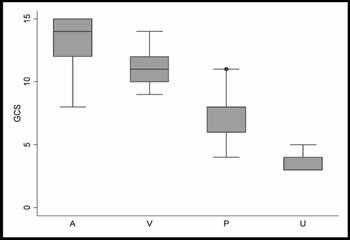|
|
|
Indian Pediatr 2011;48: 331-332 |
 |
Comparison of
Alert-Verbal-Painful-Unresponsiveness Scale and the Glasgow Coma
Score |
|
Shomi Raman, V Sreenivas, JM Puliyel and Nirmal Kumar
Department of Pediatrics, St. Stephen’s Hospital,
Tis Hazari, Delhi, India.
Email: [email protected]
|
To determine how the AVPU (alert, verbal, painful, unresponsiveness)
scale corresponds to Glasgow Coma Score (GCS), we compared the two
scales. Two months to 12 years old patients were included in the study.
The median GCS score (inter quartile range) for A/V/P/U were 14 (12-15),
11 (10-12), 6 (5.5-8) and 3 (3-4), respectively.
Key words. AVPU, GCS / modified GCS, Pediatrics, PICU.
|
|
Assessment of level of consciousness forms a crucial component of the
evaluation of sick children [1]. The Glasgow Coma Scale (GCS) score is one
of the most commonly used methods [2-7]. The Alert Verbal Painful
Unresponsiveness (AVPU) scale is a simpler method of assessment of
consciousness [8]. The two scales have been compared in 3 adult studies
[1,3,8]. They have not been compared in pediatric intensive care patients.
We conducted this study to determine how the AVPU responsive scale
corresponds with the GCS in children admitted to a pediatric intensive
care unit.
This was a prospective cohort study. Children with
poisoning and children who had received anticonvulsants or sedation were
excluded. The pediatric registrar assessed the consciousness level at
admission using the 2 scales. Pre-verbal children were assessed on the
modified GCS score. Assuming the difference in mean GCS score was
characterized by a variance of means of 5.5 and assuming that the common
SD was 4, it was determined that at least 11 readings in each AVPU score
would be needed for a one way ANOVA with 90% power to detect significance
at 5% level. Accordingly the study was continued till a minimum of 11
patients were enrolled in each of the 4 categories A/V/P/U. The GCS and
AVPU readings of each patient were compared. The median GCS score for each
AVPU component was determined and a one way analysis of variance technique
was employed. Bonferroni correlation was used for multiple comparisons.
159 patients (mean age 18 months) were enrolled to meet
the sample size stipulation. Out of the total 159 cases, 99 (67%) were
alert, 12 (7.55%) were responsive to voice, 37 (23.27%) were only
responsive to painful stimuli and 11 (6.92%) were unresponsive.
 |
|
Fig. 1 Box–and–whisker plot showing median
GCS scores for the AVPU responsive scale. The boxes represent the
IQR; the whisker represent the range. |
Comparison between GCS/modified GCS and AVPU scores are
shown in Figure 1. Those who responded to pain had a median
GCS score of 6 with IQR 5.5-8. Unresponsive patients had median GCS score
of 3 with IQR 3-4. One-way analysis of variance indicated that all the
components of AVPU had significantly different average GCS scores (P
< 0.001). Bonferroni corrected multiple comparisons indicated no two
components are similar with respect to the GCS score.
Our data would suggest that A/V/P/U corresponds with
median GCS score of 14 (12-15), 11 (10-12), 6 (5.5-8) and 3 (3-4),
respectively. As may be expected, there is some overlap between the range
of GCS score corresponding to each AVPU responsive scale category but our
IQRs are distinct from each. Another study in adults have previously shown
similar results, and the corresponding scores in adults were 15, 12, 8 and
3 [9]. The good correlation seen in our study suggests that there is a
constant relationship between these two scores in pediatric patients.
References
1. McNarry AF and Goldhill DR. Simple bedside
assessment of level of consciousness: Comparison of two simple assessment
scales with the GCS. Anaesthesia. 2004;59:34-7.
2. Matis G, Birbilis T. The Glasgow Coma Scale-a brief
review. Past, present, future. Acta Neurol Belg. 2008;108:75-89.
3. Kely CA, Upex A, Bateman DN. Comparison of
consciousness level assessment in the poisoned patients using the
alert/verbal/painful/unresponsive and Glasgow coma scale. Ann Emerg Med.
2004;44:108-13.
4. Holmes JF, Palchak MJ, MacFarlance T, Kuppumann N.
Performance of the Pediatrics Coma Scale in children with blunt head
trauma. Acad Emerg Med. 2005;12;814-19.
5. Gill M, Martem K, Lynch EL, Sallh A, Green SM.
Interrater reliability of 3 simplified neurologic scales applied to adults
presenting to the emergency department with altered level of
consciousness. Ann. Emerg Med. 2007;49:403-7.
6. Macartney DP, Mackway-Jones K, Oakley P. Safe
Transfer and Retrieval: The Practical Approach. BMJ Books. 2002.
7. Teasdale G, Jennet B. Assessment of Coma and
impaired consciousness. Lancet. 1974;ii:81-4.
8. Advanced Life Support Group. Advance Pediatric Life
Support – The Practical Approach, 2nd ed. London : BMJ Publishing Group;
1997.
9. Mackay CA, Burke DP, Burke JA, Porter KM, Bowden D,
Gormen D. Association between the assessment of conscious level using AVPU
system and GCS. Pre hospital Immediate care. 2000;4:17-9.
|
|
|
 |
|

